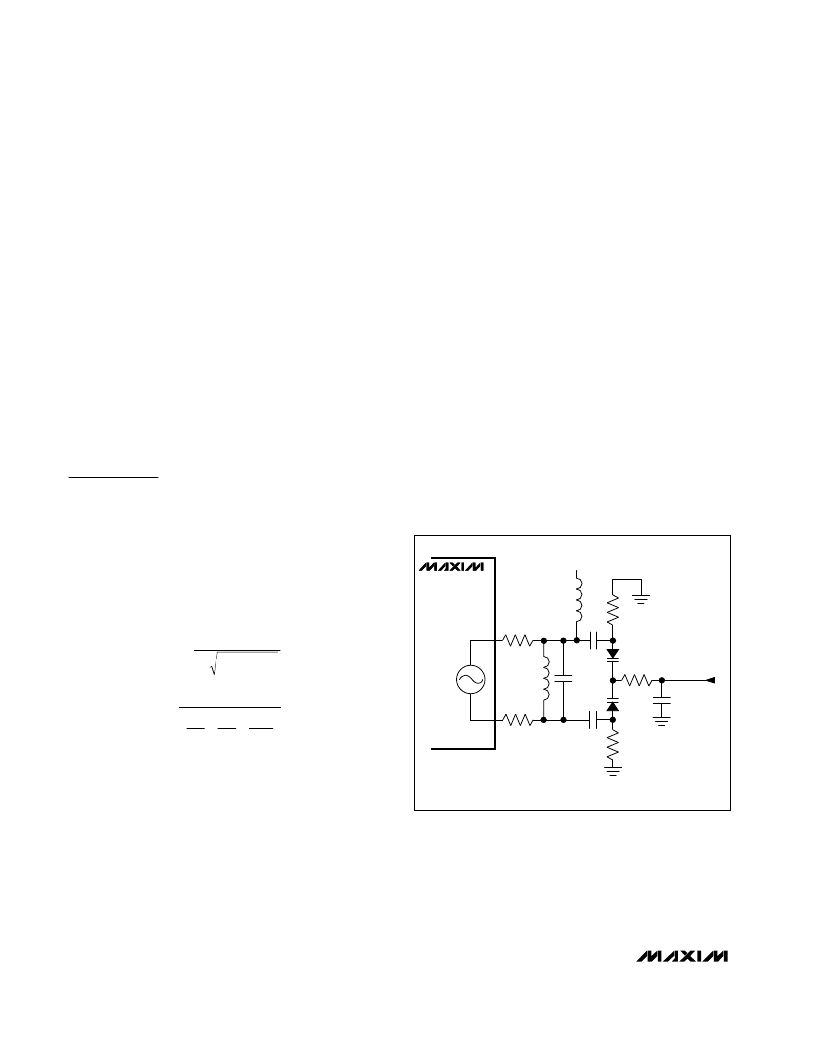- 您現(xiàn)在的位置:買賣IC網(wǎng) > PDF目錄385524 > MAX2442EAI (MAXIM INTEGRATED PRODUCTS INC) 900MHz Image-Reject Receivers PDF資料下載
參數(shù)資料
| 型號: | MAX2442EAI |
| 廠商: | MAXIM INTEGRATED PRODUCTS INC |
| 元件分類: | 無繩電話/電話 |
| 英文描述: | 900MHz Image-Reject Receivers |
| 中文描述: | TELECOM, CELLULAR, RF AND BASEBAND CIRCUIT, PDSO28 |
| 封裝: | 5.30 MM, 6.50 MM PITCH, SSOP-28 |
| 文件頁數(shù): | 10/12頁 |
| 文件大小: | 107K |
| 代理商: | MAX2442EAI |

M
900MHz Image-Rejec t Rec eivers
10
______________________________________________________________________________________
To disable the prescaler entirely, leave PREGND and
PREOUT floating. Also tie the MOD and DIV1 pins to
GND. Disabling the prescaler does not affect operation
of the VCO stage.
Power Management
MAX2440/MAX2441/MAX2442 supports three different
power-management features to conserve battery life.
The VCO section has its own control pin (VCOON),
which also serves as a master bias pin. When VCOON is
high, the LO, quadrature LO phase shifters, and
prescaler or LO buffer are all enabled. The VCO can be
powered up prior to receiving to allow it to stabilize. With
VCOON high, bringing RXON high enables the receive
path, which consists of the LNA, image-reject mixers,
and IF output buffer. When this pin is low, the receive
path is inactive.
To disable all chip functions and reduce the supply
current to typically less than 0.5μA, pull VCOON, DIV1,
MOD, and RXON low.
Applic ations Information
Osc illator T ank
The on-chip oscillator requires a parallel-resonant tank
circuit connected across TANK and
TANK.
Figure 2
shows an example of an oscillator tank circuit. It typically
oscillates between 902MHz + IF and 928MHz + IF with a
control voltage between 0 and 3.3V. Inductor L4 pro-
vides DC bias to the tank ports. L3 and the series combi-
nation of capacitors C2, C3, and both halves of the
varactor diode capacitances set the resonant frequency
as follows:
where C
D1
is the capacitance of one varactor diode.
Choose the tank components according to your appli-
cation needs, such as phase-noise requirements, tun-
ing range, and VCO gain. Higher-Q inductors yield
lower phase noise but are more likely to produce a sec-
ond-harmonic oscillation mode. Air-core spring induc-
tors provide high Q, but radiate more than chip
inductors. It may be necessary to shield the tank circuit
for optimal isolation of the LO to other circuitry. R6 and
R7 are 5
to 10
resistors that reduce the Q of para-
sitic resonances due to package inductance.
Osc illator-T ank PC Board Layout
The parasitic PC board capacitance, as well as PCB
trace inductance and package inductance, can affect
oscillation frequency, so be careful in laying out the PC
board for the oscillator tank. Keep the tank layout as
symmetrical, tightly packed, and close to the device as
possible to minimize LO feedthrough. When using a PC
board with a ground plane, a cut-out in the ground
plane (and any other planes) below the oscillator tank
will reduce parasitic capacitance.
Using an External Osc illator
If an external 50
LO signal source is available, it can
be used as an input to the TANK or
TANK
pin in place
of the on-chip oscillator (Figure 3). The oscillator signal
is AC coupled into the TANK pin and should have a
level of about 0dBm from a 50
source. For proper
biasing of the oscillator input stage, TANK and
TANK
must be pulled up to the V
CC
supply via 50
resistors.
If a differential LO source such as the MAX2620 is
available, AC couple the inverting output into
TANK
.
C
=
1
1
3
C
1
C2
EFF
+
+
+
2
26
1
C
C
D
f =
1
2
EFF
π
( )(
)
MAX2440
MAX2441
MAX2442
TANK
L3
C26
L4
100nH
R5
1k
R4
1k
D1 = ALPHA SMV1299-004
SEE FIGURE 1 FOR C2, C3, C26, AND L3 COMPONENT VALUES.
1/2 D1
1/2 D1
C1
47pF
VCO_CTRL
R7
10
R6
10
C3
R8
47k
C2
V
CC
TANK
Figure 2. Oscillator Tank Schematic, Using the On-Chip VCO
相關(guān)PDF資料 |
PDF描述 |
|---|---|
| MAX250 | 5V Powered Isolated RS232 Driver / Receiver(5V,隔離的,120kbps,自動關(guān)閉方式,RS-232收發(fā)器) |
| MAX2653EUA | GSM900 and DCS1800/PCS1900 Dual-Band, Low-Noise Amplifiers |
| MAX2651 | Hex Buffers/Drivers With Open-Collector High-Voltage Outputs 14-SOIC 0 to 70 |
| MAX2651EUB | GSM900 and DCS1800/PCS1900 Dual-Band, Low-Noise Amplifiers |
| MAX2652 | GSM900 and DCS1800/PCS1900 Dual-Band, Low-Noise Amplifiers |
相關(guān)代理商/技術(shù)參數(shù) |
參數(shù)描述 |
|---|---|
| MAX2442EAI+ | 功能描述:射頻接收器 Integrated Circuits (ICs) RoHS:否 制造商:Skyworks Solutions, Inc. 類型:GPS Receiver 封裝 / 箱體:QFN-24 工作頻率:4.092 MHz 工作電源電壓:3.3 V 封裝:Reel |
| MAX2442EAI+T | 功能描述:射頻接收器 Integrated Circuits (ICs) RoHS:否 制造商:Skyworks Solutions, Inc. 類型:GPS Receiver 封裝 / 箱體:QFN-24 工作頻率:4.092 MHz 工作電源電壓:3.3 V 封裝:Reel |
| MAX2442EAI-T | 功能描述:射頻接收器 RoHS:否 制造商:Skyworks Solutions, Inc. 類型:GPS Receiver 封裝 / 箱體:QFN-24 工作頻率:4.092 MHz 工作電源電壓:3.3 V 封裝:Reel |
| MAX244C/D | 功能描述:RS-232接口集成電路 RoHS:否 制造商:Exar 數(shù)據(jù)速率:52 Mbps 工作電源電壓:5 V 電源電流:300 mA 工作溫度范圍:- 40 C to + 85 C 安裝風(fēng)格:SMD/SMT 封裝 / 箱體:LQFP-100 封裝: |
| MAX244C/D DIE | 制造商:Maxim Integrated Products 功能描述: |
發(fā)布緊急采購,3分鐘左右您將得到回復(fù)。